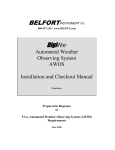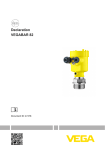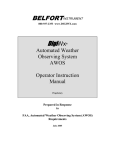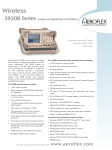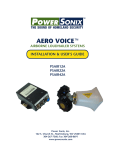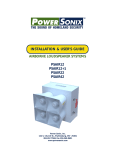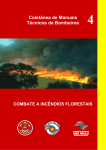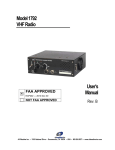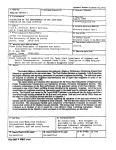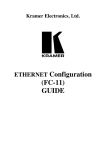Download AWOS System Description
Transcript
BELFORTINSTRUMENT 8009372353 www.DIGIWX.com DigiWx ® Automated Weather Observing System AWOS System Description Proprietary Prepared in Response to FAA, Automated Weather Observing System (AWOS) Requirements July 2005 Table of Contents System Description Paragraph 1.0 1.1 1.2 1.3 1.4 2.0 3.0 3.1 3.2 3.3 3.4 3.5 3.6 3.7 3.8 3.8.1 3.9 3.10 3.11 4.0 4.1 4.2 4.3 4.4 5.0 5.1 5.2 Description Page Introduction .................................................................................................. 1 Purpose......................................................................................................... 1 Scope............................................................................................................ 1 System Overview and Description ................................................................ 1 System Configuration ................................................................................... 2 Lowest Level Field Replaceable Components Matrix.................................... 5 Principles of System Operation ..................................................................... 7 DATU........................................................................................................... 8 DCP.............................................................................................................. 9 DDR ............................................................................................................. 9 RIF ............................................................................................................... 10 MCIF…………………………………………………………………………. 10 Dual Barometer Sensors ............................................................................... 11 Temperature Dew Point Sensor..................................................................... 14 Visibility Sensor ........................................................................................... 15 Ambient Light (Day Night) Sensor ............................................................... 18 Wind Speed Sensor....................................................................................... 21 Wind Direction Sensor.................................................................................. 21 System Power ............................................................................................... 21 System Software Descriptions....................................................................... 22 DigiWx Advisor ........................................................................................... 22 DigiWx Phone .............................................................................................. 22 DigiWx Voice............................................................................................... 23 DCP configuration software (ASOSDCP102) .............................................. 23 Applicable Documents & List of Acronyms.................................................. 23 Applicable Documents.................................................................................. 23 List of Acronyms .......................................................................................... 23 Tables Table 1. Table 2 DigiWx Configurations................................................................................. Lowest Field Replaceable Components......................................................... 3 5 Figures & Illustrations Figure 1 Figure 2 Figure 3 Figure 4 Interior and Exterior System Components .................................................... Information Flow .......................................................................................... Illustration of Data Interface Modes .............................................................. Illustration of DCP Functions........................................................................ 2 7 9 9 i BELFORT INSTRUMENT Proprietary Information This page intentionally left blank. ii BELFORT INSTRUMENT Proprietary Information 1.0 Introduction 1.1 Purpose – This manual has been prepared to identify the hardware components to the lowest field replaceable unit, describe system hardware and software principles of operation and describe how they are integrated within the system. 1.2 Scope – This manual has been prepared to comply with the guidance and requirements of FAA Advisory Circular, AC No. 150/522016C and other referenced documents. 1.3 System Overview and Description – The DigiWx™ system is an FAA approved, special configuration AWOS with dualpressure sensors and visibility sensors for reporting official altimeter settings and visibility measurements in addition to other advisory information. It is a fully automated aviation weather observing and reporting system designed to support airborne and ground users. The DigiWx system is modular and may be installed in a number of configurations (see Table 1). A full DigiWx™ system consists of FAA approved barometric pressure sensors and a visibility sensor. The system may contain additional advisory sensors such as wind speed, wind direction, temperature, and humidity sensors mounted on a rugged, aluminum tiltover tower. Sensor readings are monitored and processed by a digital processor located in the DCP enclosure. The processor uses sensor data to calculate the prevailing and gust wind components for preprogrammed runway headings. Depending on the system sensor configuration purchased, the DigiWx™ system calculates the altimeter setting, density altitude, condensation altitude, and dew point. All of this information plus the speed and direction of prevailing wind and wind gusts, current surface temperature and visibility are broadcast on UHF 464 MHz by a FCC licensed transceiver located in the DCP enclosure. Through DigiWx Advisor software and a Digital Data Receiver (DDR), the weather information and any NOTAMs are communicated to users by Pilot Activated Unicom or an Endless Loop Dedicated Frequency (ELDF) on a dedicated VHF frequency. An internet option and dial up voice modem allow remote users to access the information. The system also reports weather conditions to pilots in the air through the DigiWx™ AWOS HandHeld Display Unit (HHDU). The pilot receives this information at ranges up to 10 miles from the airport. In order to get the weather information, the pilot only has to power up the hand held display and select the runway heading that he/she will use. In addition to alphanumeric readouts of the various weather parameters, the hand held unit provides a graphical representation of the selected runway with the head, tail and/or cross wind components displayed thereon. DigiWx™ system software design also incorporates plug and play simplicity for ease of installation and maintenance, and an intuitive interface for ease of operation. 1 BELFORT INSTRUMENT Proprietary Information 1.4 System Configuration Figure 1a illustrates a typical DigiWx installation with all sensor options installed and the solar power option added. Interior DigiWx Data Acquisition Terminal Unit Exterior DigiWx Tower Figure 1 Interior and Exterior System Components 2 BELFORT INSTRUMENT Proprietary Information The system is modular and may be deployed in a number of configurations depending on the sensors selected, the mounting method, and the output options as shown in the following table. DigiWx Sensor and Data Distribution Configurations Sensor Configurations Code BNT B BV W DCP Dual Baro Tower Mount Wind Speed and Direction Temperature and Dew point Visibility with Day/Night Sensor V H A1 A2 BNTH BNTA1 BNTA2 BH BA1 BA2 BVH BVA1 BVA2 BWH BWA1 BWA2 BWVH BWVA1 BWVA2 BWSH BWSA1 BWSA2 A3 BNTA3 BA3 BVA3 BWA3 BWVA3 BWSA3 A4 BNTA4 BA4 BVA4 BWA4 BWVA4 BWSA4 V1 BNTA*V1 BA*V1 BVA*V1 BWA*V1 BWVA*V1 BWSA*V1 V2 BNTA*V2 BA*V2 BVA*V2 BWA*V2 BWVA*V2 BWSA*V2 DCP Dual Baro Wall Mount Data Distribution Options Handheld (HHDU) ** DigiWx Advisor – FBO DigiWx Advisor FBO – Internet DigiWx Advisor FBO – Dial In DigiWx Advisor FBO – Internet Dial In With DigiWx Voice – UNICOM Or DigiWx Voice VHF DCP Dual Baro Tower Mount Visibility Day/Night DCP Dual Baro Tower Mount DCP Dual Baro Tower Mount Wind Speed and Direction Temperature and Dew point DCP Dual Baro Wind Sock Mount Wind Speed and Direction Temperature and Dew point Visibility with Day/Night Sensor S Table 1 DigiWx Configurations * DigiWx Voice requires the presence of one of the DigiWx Advisor modules – A1, A2, A3 or A4. ** All systems are supplied with one Hand Held Display Unit. A solar power option is available for all configurations and is denoted by appending “SP” to the above designators. Details of the configurations in the shaded boxes above are listed as examples. 3 BELFORT INSTRUMENT Proprietary Information BNTH BA1 BVA3 BWA*V1 BWVA*V2 Dual Barometer DCP, wall mount, Handheld Receiver (HHDU) Dual Barometer DCP, Tower Mount, HHDU, DigiWx AdvisorFBO Dual Barometer DCP, Visibility, Tower Mount, HHDU, DigiWx Advisor FBODial In Dual Barometer DCP, Tower Mount, Wind Speed and Direction, Temperature and Dewpoint, HHDU, DigiWx Advisor A1, A2, A3 or A4, DigiWx Voice on UNICOM Dual Barometer DCP, Tower Mount, Wind Speed and Direction, Temperature and Dewpoint, HHDU, Visibility, DigiWx Advisor A1, A2, A3 or A4, DigiWx Voice on Dedicated VHF 4 BELFORT INSTRUMENT Proprietary Information 2.0 Lowest Level Field Replaceable Components Matrix The following table illustrates the lowest possible field replaceable unit (FRU). PARTS LIST ITEM 1 2 3 4 5 6 7 8 9 10 11 12 13 14 15 16 17 18 19 20 21 22 23 24 25 26 27 28 29 30 31 32 33 34 35 36 37 38 39 40 PART # 80010 80035 679501 80089 80018 22167 22168 679401 80014 80015 80016 80017 ZXSRS8HC R13HYCLIPS3 ZXMUF4502 872001 872101 872801 ZX1324U2 ZX1242DPCHR 80003 800031 800032 80057 ZXRPG125 ZX3827T34 ZX4491K42 ZXS56 SCP30S15DN ZXA8R84 80152 80009 80090 80097 80091 80087 90000 DESCRIPTION Instruction Manual HHDU User Manual Hand Held Receiver Pole and Harness Computer and Monitor Cross Arm Channel DCP Enclosure Assy Wind Speed Bottle Wind Direction Bottle Wind Speed Cups Wind Direction Vane Solar Radiation Shield Temperature/Humidity Sensor Antenna Harness, Tower Harness, Power Cable, Antenna Cap, End Eye Strap Battery Bracket Battery Box Solar Panel Solar Panel Mounting Kit Weights Nylon Rope Cap Plug, Red Solar Controller Power Supply Junction Box and circuit breaker Battery backup power cable Ground Cable Lightning Rod Mounting Plate Data Comm Cable DCP Mounting Kit Visibility Sensor 80098 92000 SFL612100 Hardware Kit, Visibility meter Day Night Sensor Power Supply QTY 1 1 1 1 1 1 1 1 1 1 1 1 1 1 1 1 1 1 2 1 1 1 1 1 3 1 6 1 1 1 1 1 1 1 2 1 INSTALLATION REF Figs 5, 6, 7, 15, & 16 Fig 18 Figs 5a & 7 Fig 6 Fig 8 Fig 10 Fig 11 Fig 10 Fig 11 Fig 12 Fig 12 Fig 5a Fig 5 Fig 5a Fig 5a Fig 10 & Fig 11 Fig 5a Fig 15 Fig 16 Fig 14 Fig 14 Fig 5 Fig 6 Fig 10 & Fig 11 Fig 16 Fig 17 Fig 17 Fig 17 Figs 6 & 17 Fig 5a Fig 13 Fig 9 Fig 13 1 1 1 Fig 13 Fig 13 Fig 17 5 BELFORT INSTRUMENT Proprietary Information ITEM 41 42 43 44 45 46 47 48 49 50 51 PART # SFL612100 LPC 102627? 80040 80041 80039 90001 80109 80110 80111 80113 80156 DESCRIPTION Power Supply Surge Suppressor DDR & Power Supply DDR Comm Cable RIF Calibration Kit Obstruction Light and wiring harness kit Base Transceiver Pressure Vent Kit ELDF Base Transceiver MCIF QTY 1 1 1 1 1 1 1 INSTALLATION REF Fig 17 Fig 17 Fig 19 Fig 19 Fig 19 Fig 5a 1 2 2 1 Fig 5a Fig 5a Fig 5a Fig 19 Table 2 Lowest Field Replaceable Components 6 BELFORT INSTRUMENT Proprietary Information 3.0 Principles of System Operation Once every 5 seconds, a proprietary digital message containing all the weather information and DCP system status is transmitted from the DCP to the HHDU, and the DDR and DATU via a 464 MHz FM link. This information is displayed directly by the HHDU, and decoded by the DDR and passed to the DATU as an ASCII string. The information is then parsed by the DATU and made available to various users through on screen displays, synthesized voice audio information via pilot activated Unicom, endless loop synthesized voice audio information via dedicated frequency Unicom, telephone dial in via an audio modem, and if available, through an Internet link. Figure 2 displays this information flow. Figure 2 Information Flow 7 BELFORT INSTRUMENT Proprietary Information 3.1 DATU (Data Acquisition Terminal Unit) and Peripheral Devices The DATU consists of 5 basic modules: 1. A digital data receiver (DDR) that links the sensors and DCP to the PC based user interface. 2. A PC and peripherals meeting at least the following requirements: Dell Optiplex GX270 PC Minimum of 128MB RAM 20GB Hard Drive 1 GHz Pentium Processor Windows XP Home Edition Voice Modem V.92 Sound Card (Sound Blaster Compatible) Network Interface Card (NIC) 10MB Minimum Monitor 3. A radio Interface (RIF) that links the MCIF with the PC 4. A Microphone Click Interface (MCIF) that links the VHF transceiver with the PC and the RIF. 5. An aviation VHF base station, Technisonics TLC100 Interconnect cables, adapters and power supplies The DATU provides the user interface for all modes of operation other than the Hand Held Display Unit (HHDU). These interfaces are: DigiWx Advisor display available locally and through an Internet link DigiWx Voice available through a pilot request, a dedicated frequency endless loop audio broadcast, telephone dial in request. 8 BELFORT INSTRUMENT Proprietary Information Figure 3 Illustration of Data Interface Modes 3.2 DCP (Data Collection Processor) The DCP is located on the sensor tower, and collects, processes and communicates the weather and system status information. It also contains the 2 barometric pressure sensors, and battery charging circuitry for the backup battery supply. The 464 MHz transceiver listens before transmit and has automatic alternate channel capability. Figure 4 Illustration of DCP Functions 3.3 DDR (Digital Data Receiver) The DDR is a “blackbox” component with power switch, AC adapter jack, antenna and DB9 RS232 (serial port) connector. The DDR contains a receiver to receive data transmissions from 9 BELFORT INSTRUMENT Proprietary Information the DCP, and signal processing components to convert the received data into a serial ASCII data stream for input to the DATU’s computer’s Serial port interface. 3.4 RIF The radio interface (RIF) is an analog audio processor that performs level control and compression on both radio to pilot activated computer and computer voice synthesizer to radio analog audio streams. The RIF also keys the aviation base station radio in voice activated and endless loop configurations. A microphone allows the transceiver to be used in a normal manner if required. 3.5 MCIF The microphone click interface (MCIF) is both an audio pass through and digital processing device. All audio signals between the RIF and the radio pass through the MCIF with no processing. The MCIF processes radio squelch levels converting them to digital messages to the computer. 10 BELFORT INSTRUMENT Proprietary Information 3.6 Dual Barometer Sensors The dual barometric pressure sensors are located in the DCP enclosure, and provide serial pressure data to the altimeter reporting algorithm. The pressure sensors are sampled once every 10 seconds and 1 minute averages are constructed. The 2 averages are compared and the lower is used to compute field pressure. If the pressures differ by more than 0.04 inHg, the pressure is reported missing. The altimeter algorithm calculates and reports altimeter setting and density altitude. The altimeter setting is rounded to the nearest 0.01 inHg. The following flow chart describes the algorithm for calculating Altimeter Setting data: Algorithm Flow Diagram for Pressure and Altimeter Setting Data Cache raw instantaneous data for use by calibration functions and routines. === ============================== === Every 2 seconds, request pressure data from sensor #1 and sensor #2, P1 and P2 || Every 10 seconds, insert the most recent pressures data into the P1 and P2 6 element circular averaging buffers. If data not available, insert NA into that position. || Once every minute, if the number of valid entries equals 6, calculate the 1 minute averages for P1 and P2. If a data point is missing or the buffer is not full, output NA. Yes AS=NA || || 11 BELFORT INSTRUMENT Proprietary Information Algorithm Flow Diagram for Pressure and Altimeter Setting Data (Continued) Once every minute, calculate the altimeter setting from the average pressure data for P1 and P2 as follows: || Are both 1 minute P1 and P2 average pressures available? Yes AS=NA Yes AS=NA || Do the average values differ by more than 0.04 inHg? || Once each minute, using the lower of average P1 and P2, calculate field pressure (Pa) using the equation Pa=P*10^(KH/TR) where: P=lower of average P1 and P2, K=0.008135, H=difference in feet between the elevation of the pressure sensor (Hz) and the field elevation of the airport (Ha), T=current 5 minute average temperature in degrees Rankin. || || 12 BELFORT INSTRUMENT Proprietary Information Algorithm Flow Diagram for Pressure and Altimeter Setting Data (Continued) || If Pa is missing because Temperature is not available, calculate Altimeter Setting (AS) using the equation: AS=(P^N+KHz)^1/N where: P=lower of average P1 and P2, N=0.019263, 1/N=5.25588, K=1.3126*10^5 and Hz=Elevation of the pressure sensor in feet above MSL. Once each minute, calculate Altimeter Setting (AS) using the equation AS=(Pa^N+KHa)^1/N where: Pa = Field Pressure, N=0.190263, 1/N=5.25588, K=1.3126*10^5, Ha=Field elevation of he airport in feet above MSL. || Round AS to the nearest 0.01 inHg. Midpoint values shall be rounded down. || Make sure the AS is within the allowable range, more than 26.0 inHg and less than 32.0 inHg No AS=NA Yes AS=NA || Report Lower of unaveraged P1 and P2 === ============================== === If the DigiWx DCP Alert="DigiWx being serviced" || If DCP IPC is down || Once a minute, report Altimeter Setting (AS) as calculated 13 BELFORT INSTRUMENT Proprietary Information 3.7 Temperature Dew Point Sensor The temperature and humidity sensor is located in the naturally aspirated enclosure mounted near the top of the sensor tower. This sensor provides digital information to the DCP for use in the temperature, dew point, humidity and density altitude algorithms. 14 BELFORT INSTRUMENT Proprietary Information 3.8 Visibility Sensor The Belfort Model 6000 forward scatter visibility sensor including the Belfort Model 6300 daynight sensor operates in the polled mode. The DCP requests data once a minute and the 6000 responds with an ASCII data string including status of the visibility and daynight sensors, a one (1) minute average extinction coefficient (ExCo), and the ALS reading in footlamberts. The DCP then calculates visibility using the relationships: Visibility =. 6213712 X 3.0/Exco Daytime in miles Ln(.00336V)/V=Exco Night Time in miles DCP Flow Diagram for Reported Visibility Once each minute poll VS for daytime ExCo and ALS background illumination values. Non Valid Data Mark “NA” Valid Data Determine Day /Night status Day to Night =<0.5 fl Night to Day =>3.0 fl || Calculate one (1) minute visibility in miles Day = 0.62137X3.0/ExCo Night Ln(.00336V)/V=ExCo If Day/Night indeterminate, use Daytime visibility || Store one (1) minute visibility value rounded to nearest 0.1 mile in ten (10) minute array, replacing oldest value if any || 15 BELFORT INSTRUMENT Proprietary Information DCP Flow Diagram for Reported Visibility (continued) On startup, report “NA” until all ten (10) elements are filled and a ten (10) minute harmonic can be calculated. Subsequently, report “NA” if less than 8 valid elements are present in the array. || Calculate and report variable visibility if the ten (10) minute average is greater than three (3) miles, all ten (10) array elements are filled, and the element to element differences, and sign reversals exceed threshold values >>>> >>>> Incorporate in the METAR output The Visibility Sensor samples light forward scattered from the sample volume 37 times each second as Phase I and 37 times each second as Phase II. A synchronous rectifier detects the difference from an arbitrary zero. Also the power of the illuminating LED is sampled in the same way. The one (1) second and average differences are converted to Extinction Coefficient in inverse kilometers as a function of the difference, span and zero factors. The Extinction coefficient is converted to visibility using the formula V=3/ExCo in kilometers, and then converted to units of choice. Every 30 seconds, the ALS is polled by the Visibility Sensor, and the one (1) minute average information is stored in a buffer available through the Visibility Sensor as a response to an “FE” poll. The Visibility Sensor is polled once each minute by the DCP for the one (1) minute average visibility, and the 30 second average ALS data. 16 BELFORT INSTRUMENT Proprietary Information Algorithm Flow Diagram for Visibility Sensor Sample the forward scattered light thirty seven (37) times each second in Phase I and Phase II. Sample the illuminating LED power thirty seven (37) times each second as Pwr. || Subtract Phase II from Phase I to generate a one (1) second RcvrAvg || Add the one( 1) second average to the Painting Average || Adjust the average for power: AvgRcvr=RcvrAvgXTxPwrCal Pwr Where TxPwrCal is a calibration value || Convert to Extinction Coefficient (ExCo) in inverse kilometers as AvgExCo=f(AvgRcvr, Span, Zero) AvgExCo available for polling by the DCP >>>>> >>>>>>>>>>>>>>>>>>>>>>>> >>>>> Where DCP polling command is “FL” Where Span and Zero are calibration values From ALS, one (1) minute average ALS data available for polling by the DCP Where DCP Polling command is “FE” 17 BELFORT INSTRUMENT Proprietary Information 3.8.1 Ambient Light (Day Night) Sensor The Belfort Model 6300 Ambient Light Sensor (ALS) measures the luminance of a 6º cone of sky as required for day / night determination. The visibility sensor powers the ALS and communicates with the ALS through a fivefoot long cable by which the two sensors are connected. The Ambient Light Sensor (ALS) continuously samples background illumination, calculates ten (10) second averages, and once (1) a minute, calculates a one (1) minute average from the ten (10) second averages. If a valid one (1) minute average is calculated, this information is made available for a polling request by the Visibility Sensor (VS). If a valid one (1) minute average is not calculated, the output is marked “NA”, and will deliver a null when polled. Algorithm Flow Diagram for ALS Sensor Make ambient light measurements as fast as possible, from one (1) cycle per second to two hundred (200) cycles per second depending on illumination level. || Once every ten (10) seconds, calculate a ten (10) second boxcar average || If a valid ten (10) second average is available, set the boxcar count to six (6) No If a valid ten (10) second average is not available, set the boxcar count to last count less one(1) Yes = Six (6) valid boxcar averages available for one (1) minute average calculation Or Five (5) or less valid boxcar averages available for one (1) minute average calculation || Once every ten (10) seconds, determine if at least five (5) active boxcar averages are available No yes Once every ten (10) seconds, calculate one (1) minute average Yes 18 BELFORT INSTRUMENT Proprietary Information Algorithm Flow Diagram for ALS Sensor (Continued) If the time since last availability of 75% of six (6) active boxcars is less than sixty (60) seconds, “coast” the last one (1) minute average = Is a one (1) minute average available, current or coasted? No ALS=NA yes New one (1) minute average passed to the Visibility Sensor and made available for polling by the DCP Where DCP Polling command is “FE” 19 BELFORT INSTRUMENT Proprietary Information 20 BELFORT INSTRUMENT Proprietary Information 3.9 Wind Speed Sensor The wind speed sensor generates a pulse with the frequency proportional to the wind velocity. This pulse frequency is sampled once a second by the DCP and processed to construct the 2 minute average and gust information, along with sensor health and data quality determinations. Reported wind speed is rounded to the nearest knot. 3.10 Wind Direction Sensor The wind direction sensor measures wind direction from 001 to 365 degrees and communicates with the DCP using a 7 bit gray code. The direction is sampled once a second and the 2 minute running average is computed every 5 seconds. Sensor health and data quality algorithms are also computed. Reported wind direction is rounded to the nearest 10 degrees. 3.11 System Power System power is made available to the DCP through a power wire harness that is connected to an 115VAC powered 12VDC power supply, and/or a 12VDC deep discharge lead acid battery. The battery may be maintained by a solar cell and charge controller. If an AC powered 12VDC supply is used, the battery is maintained by a charge controller built into the DCP. Diagnostics on both supply channels are conducted by the DCP once a minute. 21 BELFORT INSTRUMENT Proprietary Information 4.0 System Software Descriptions 4.1 DigiWx Advisor The DigiWx Advisor™ is a Belfort proprietary software program that provides a PCbased graphical display of local weather data collected from the base DigiWx Weather Station. The data can be viewed on the DATU terminal at the airport FBO or, if the optional Web Service has been installed, on the web for preflight planning purposes and general airport operations. The DigiWx Advisor has an event manager capability that provides visual alerts of important, possibly critical, weather conditions such as high density altitude or excessive crosswind component. The program captures all weather conditions to support aircraft accident or incident investigations. All historical data is saved subject only to limitations of hard disk space. If the Internet option has been installed, current data is also be transmitted to a central site where it is saved in a master database with online and offline backups for data safekeeping. Historical data saved at the master database is retained indefinitely. 4.2 DigiWx Phone The DigiWx Phone program is an optional feature that can be added to the DigiWx Advisor software. It provides the capability to automatically answer a phone line and will deliver current conditions as speech output. In order for the telephone answering and reporting system to function, a modem capable of voice output must be installed. If this option is installed, the modem will be configured at the Belfort factory. The DigiWx Phone program will answer a call on the telephone line connected to the modem. The program will usually answer before the second ring at the modem. (The caller may hear three (3) or more rings depending upon the variables in the public telephone switching network.) Once DigiWx Phone has answered the call, the program will query the database to retrieve the most current reading. The program will generate speech output into the modem for: Airport name, NOTAM message (if any), current winds and gusts, altimeter, visibility (if sensor is installed), temperature, dew point, relative humidity, density altitude and condensation altitude. The program will repeat the current conditions and will then terminate the call and hang up the phone line. Stale data threshold – A stale data threshold is preconfigured at the Belfort factory. If the most current data reading is older than the current clock time minus the stale data threshold interval, no weather parameters will be shown, and “Current data not available” will be output instead of the date and time. In the event that the stale data threshold has been exceeded, the speech message output will consist of the airport name and the phrase “Current data is not available.” 22 BELFORT INSTRUMENT Proprietary Information 4.3 DigiWx Voice A separate program, DigiWx Voice, provides speech output through the CTAF/Unicom radio upon demand from a pilot’s radio. DigiWx Voice is installed and configured at the Belfort factory. There is no operator setup or configuration required. 4.4 DCP Configuration software (ASOSDCP102) ASOSDCP102 is a Belfort proprietary program that facilitates interactive dialog between the technician and the DigiWx DCP to enter and modifying local settings. An automatic altimeter setting calibration program is also included. All settings are password protected to prevent unauthorized changes. 5.0 Applicable Documents & List of acronyms 5.1 Applicable Documents FAA AC No: 150/522016C Automated Weather Observing Systems (AWOS) For Non Federal Applications 5.2 List of Acronyms AC ALS AVG AWOS BIT CTAF DATU DC DCP DDR DMM DSL DTMF ELDF EPROM ExCo FAA FBO FCC FRDF FRU FSDO Hg HHDU Alternating Current Ambient Light Sensor Average Automated Weather Observing System BuiltInTest Common Traffic Advisory Frequency Data Acquisition Terminal Unit Direct Current Data Collection Processor Digital Data Receiver Digital Multimeter Digital Subscriber Line DualTone MultiFrequency Endless Loop Dedicated Frequency Erasable Programmable ReadOnly Memory Extinction Coefficient in inverse kilometers Federal Aviation Administration Facility Base Operator Federal Communication Commission Facility Reference Data File Field Replaceable Unit Flight Standards District Office Mercury Hand Held Display Unit 23 BELFORT INSTRUMENT Proprietary Information ICAO ID INOP KT LED LRU MCIF MHz MOU MSL NAVAID NIST NOTAM OMM RAF REL HUM RIF RPM T1 UHF UNICOM VAC International Civil Aviation Organization Identification Inoperative Knots Light Emitting Diode Lowest Replaceable Unit Microphone Click Interface MegaHertz (million Hertz) Memorandum of Understanding Mean Sea Level Navigational Aid National Institute of Standards and Technology Notice To Airmen Operations and Maintenance Manual Regional Airway Facilities Relative Humidity Radio Interface Revolutions Per Minute VDC VDD VDU VHF VS Volts Direct Current Version Description Document (DigiWx® Configuration Baseline Document) Video Display Unit Very High Frequency Visibility Sensor Tcarrier 1 (digital transmission line, 1.544 Mbps, 24 voice channels) Ultra High Frequency Universal Integrated Communications (System) Volts Alternating Current 24 BELFORT INSTRUMENT Proprietary Information




























